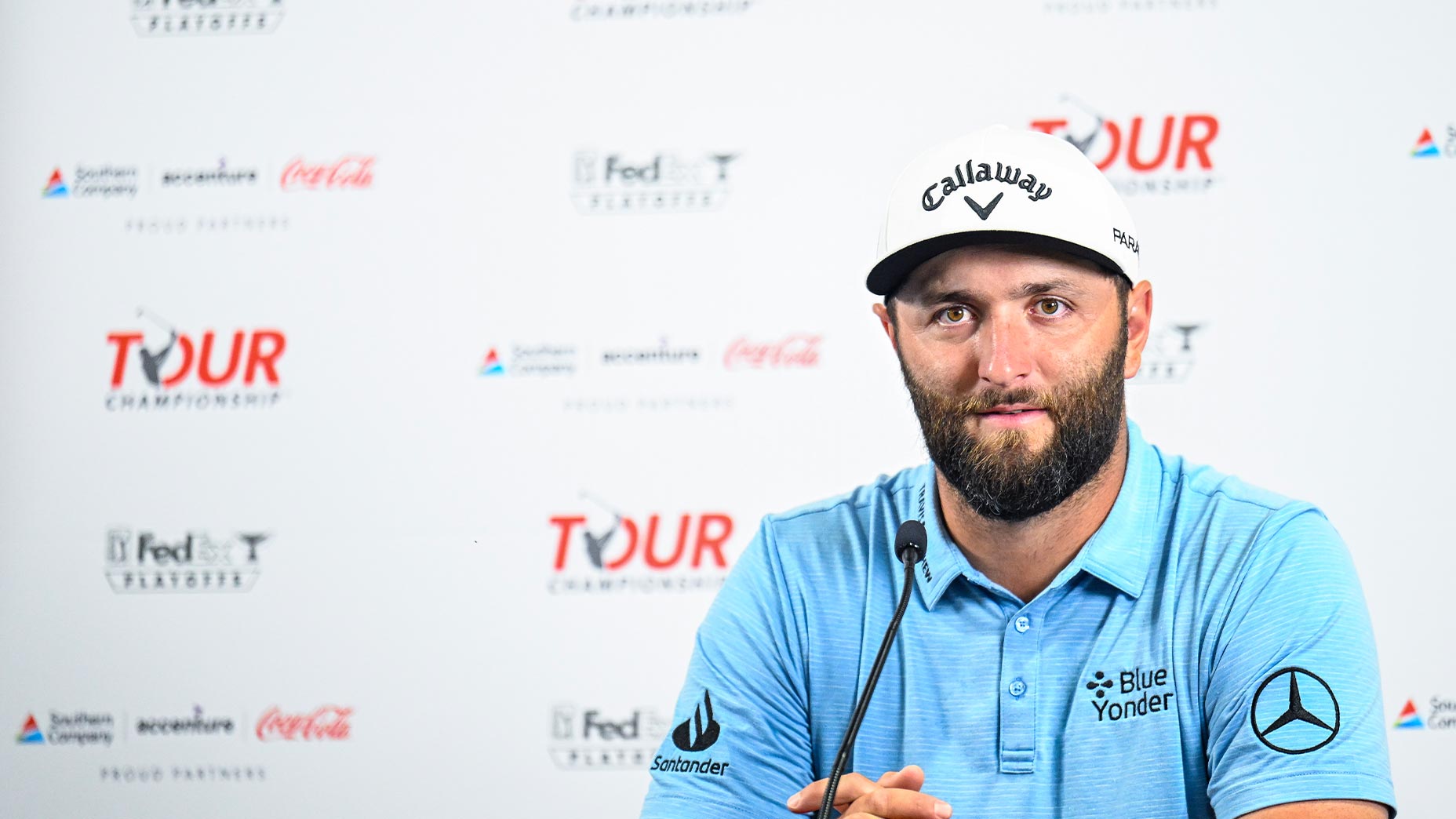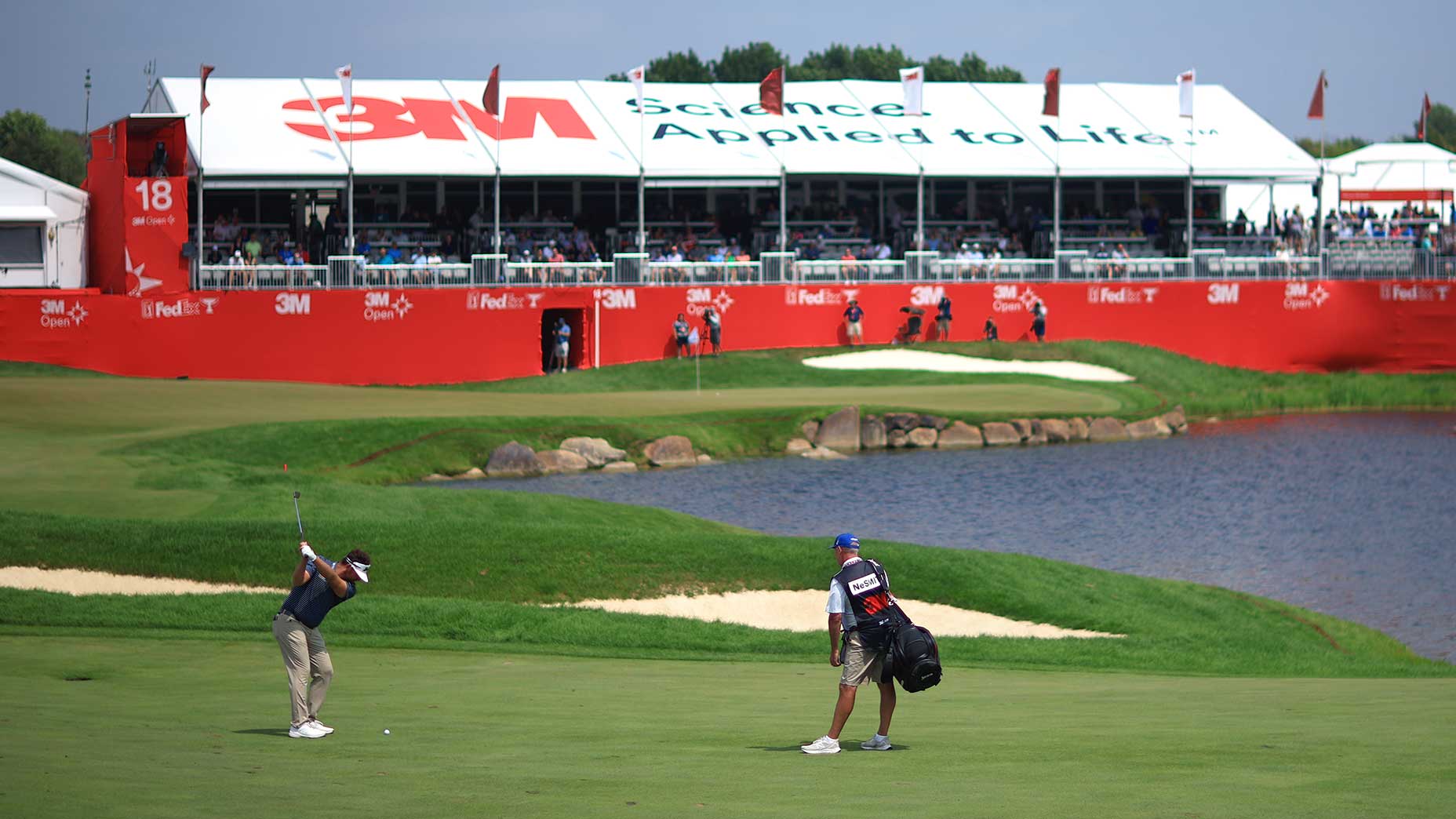Jon Rahm’s LIV departure leaves us with one massive question

Jon Rahm's LIV departure leaves the PGA Tour searching for answers.
Getty Images
The last time I saw Jon Rahm, he was in the throes of being Jon Rahm.
And on this day — a Tuesday in August at the U.S. Open tennis tournament — being Jon Rahm looked terrible.
By the time he reached us, Rahm had been the subject of interviews for the better part of a half-dozen media outlets, shmoozed gamely with no fewer than 20 corporate shills, and stopped moving for about five seconds. But most impressive of all, he looked no worse for wear. Donning a bright blue button-down shirt and slacks, he smiled gracefully and spoke earnestly. He was far more interested in the women’s quarterfinal tennis match playing beneath us than just about anyone in the luxury box we’d invaded at Arthur Ashe Stadium — interrupting his conversations to jam in bits of rapid-fire analysis — but he was surprisingly unmoved by the spectacle of people bidding for his time. In a sport filled with convivial, approachable characters, the famously hot-headed Rahm seemed to be bidding for the superlative of “most friendly.” I was awed.
But a short while later, when Rahm sat down to chat with me, I realized the toll of it all. As our video producer, Connor, set up our camera shot, I asked Rahm what he was planning to have for dinner. He paused.
“I don’t know.”
The Tour Championship had ended two days earlier. After eight straight months on the road, he told me he had ended his PGA Tour season and boarded a flight straight to New York for the day’s availabilities. In just an hour or two, he would go through the whole ordeal again, hopping on a flight back home to Scottsdale where his wife, Kelley, and two young children were waiting.
It would be their first extended time together at home in a very long while, but it wouldn’t last long. In just a few weeks, he was off to the Ryder Cup, and with the DP World Tour season concluding shortly after, he would be back on the road again for his native Spanish Open.
For just a second, Rahm broke character. He looked a kind of tired I could feel, a tired that sunk deep down in his bones.
Eventually, Rahm whirred back to life and our cameras started rolling. After a few minutes, I asked him about handling the burden of expectation. He grinned.
“Golf is a game, if you’re on the golf course for five hours, action is what? Fifty seconds at most, every five to 10 minutes?” he said. “It’s a lot of dealing with your own thoughts.”
Oh to be in Jon Rahm’s head on Thursday afternoon, the day what it means to “be Jon Rahm” changed forever.
It was on Thursday, from a hastily scheduled press conference, that LIV Golf announced it had signed Rahm to a multi-year contract rumored to be worth several hundred million dollars.
Rumors of Rahm’s alleged involvement with the rival tour had been circulating for weeks, but there was a certain finality to Thursday’s decision. In a moment, perhaps the most gifted player in modern golf had hitched his wagon to a circuit funded by the Saudi government and rumored to be weeks away from signing a peace pact with his prior employers. After “declaring” his “fealty” to the PGA Tour, and after many months of saying he would do the opposite, Rahm changed his mind in the middle of his playing prime. His legacy, that of 21 professional wins and two major championships, has forever changed.
But the bigger question, the one that has the most far-reaching implications of Rahm’s decision, has very little to do with Rahm himself. Rather, it’s the question that led to our quiet moment at the U.S. Open in August — and the question everyone involved at the PGA Tour should be seeking to answer, and fast.
Why?
Rahm’s decision to go to LIV unquestionably had something to do with money. Every decision tied to the rival league does, particularly when the sums tossed in his direction reportedly numbered well into nine figures. Rahm instantly becomes the highest-paid player in golf, a title he will carry well into the future, barring any further tectonic shifts in the golf landscape.
But money wasn’t the only factor. It couldn’t have been. For one thing, his paycheck was already plenty fat — he’s made some $65 million in on-course earnings. For another, he told us already that he didn’t need it!
“When this first thing happened, we started talking about it, we were like, ‘Would our lifestyle change if I got $400 million?’ No. It would not change one bit,” Rahm famously — and now eerily — said earlier this year. “Truth be told, I could retire right now with what I’ve made and live a very happy life and not play golf again. So I’ve never really played the game of golf for monetary reasons, I play for the love of the game, and I want to play against the best in the world.”
Even if Rahm had been motivated by cash, he wouldn’t have been doing too badly on the PGA Tour. He recorded the second-highest single-season paycheck in PGA Tour history in 2023, his $16.5 million in on-course earnings falling behind only Scottie Scheffler’s $20 million season. In 2024 and beyond, Rahm and others near the top of the Tour establishment are expected to make a boatload more, much of it coming via a “definitive agreement” with LIV’s same Saudi financiers, who will infuse the Tour model with untold billions in cash and provide Tour players with league equity for the first time. In short, if Rahm needed — or wanted — more money, all he had to do was wait.
But perhaps his decision to leave for LIV was about more than just money. After all, Rahm is among the golfers who were wounded by the actions of June 6, when the Tour and PIF first announced their shocking agreement. His decision to leave at this stage of negotiations — with a deadline set just 24 days into the future — represents unusually callous behavior. Sure, it makes sense for the PIF, which strengthens its negotiating position with the Tour and sends a clear message that LIV will charge forward if their talks fall apart. But for Rahm, the decision to leave his Tour counterparts in the lurch is at odds with everything he holds most dear: history and legacy; competition and reputation.
Rahm is a heady scholar of the game, often citing observations from decades-old tournaments he watches in his free time. Leaving the PGA Tour tosses aside more than 60 years of Tour tradition at perhaps its most vulnerable moment ever. It considerably diminishes the Tour product. It eliminates his hopes of chasing down many of his idol Tiger Woods’ records. There is an argument to be made that of all the LIV departures, including his mentor Phil Mickelson, Rahm’s is the most damaging to the professional golf landscape. So why do it?
Perhaps because LIV provides an opportunity for legacy-building that the PGA Tour never showed much interest in: the opportunity to be the face of a league, a marquee name with whom the buck will stop. Perhaps because the PGA Tour proved to Rahm that legacy matters less than life-changing money. Or perhaps because in these times of fracture in professional golf, all that really matters is earning a seat at the majors.
The life of a professional golfer is glamorous, but it is also deeply taxing. Even before LIV, the burdens of life on the road were steep. The golf schedule pulled players away from their families, challenged marriage dynamics, and pushed away a sense of normalcy in favor of an unending road trip. The upside of doing it was the chance to make millions and leave behind a legacy.
The idea that LIV’s schedule is inherently “easier” on players is a fabrication, but it hints at a deeper truth. In an era when golf’s stakeholders can’t agree on what’s important, the incentives shift to the lowest common denominator. In this instance, that’s money — and guess who still has the most of it?
There is a counterargument that our values are worth more than any amount of cash. In the coming months, Rahm will hear it plenty. He will hear his voice as part of a torrent of hypocrisy and double-speak. He will be vilified and ostracized, his name tied to human rights abuses and terrorist attacks. He will be asked to explain his behavior, and there is no doubt he will try. But no matter how much candor or earnestness he provides, he’ll never offer a satisfying answer to that first, and most elemental, question: why?
As Rahm’s future became solidified late on Thursday afternoon, I found myself reflecting on the moment at Arthur Ashe Stadium back in August. I thought about the exhaustion in his eyes, and about the weight the last few months must have carried.
I wondered if he felt relief. Or anguish.














